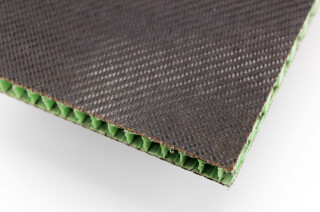Following a trial last year, Skanska is rolling out the use of a new type of reinforced concrete – one that uses no cement and no steel.
The initial trial began in December 2021 on Skanska’s £282m M42 junction 6 project for National Highways. Cement-free concrete with basalt fibre reinforcement was used on a temporary haul road for construction vehicles. The trial was conducted with the National Composites Centre, Tarmac, Basalt Technologies and National Highways.
Tarmac provided two types of concrete for the trial: a mix comprising conventional blended cementitious material and a low carbon alternative mix incorporating an alkali activated cementitious material (AACM) in place of the cement. This AACM concrete was mixed at a conventional concrete plant close to the project and installed in the same way as traditional concrete.
The reinforcement steel replacement was made of Bastech, a basalt fibre reinforced polymer rebar. This is five times lighter and twice as strong as steel rebar and is naturally resistant to corrosion, alkalis and acids.
The National Composites Centre calculated the carbon throughout the lifecycle of the structural element and carried out an environmental performance assessment.
The AACM concrete delivers a carbon footprint up to 80% lower than a standard CEM I concrete, it is claimed, while the basalt rebar averages 60% less than steel.
Because of its lightness, basalt rebar is easier to handle and transport than steel, it does not corrode or rust, and it doesn’t cause sparks when cut, meaning there is no need for a hot works permit.
The trial involved the construction of four concrete slabs on a temporary haul road:
• Slab A – conventional concrete + steel reinforcement
• Slab B – low carbon concrete + steel reinforcement
• Slab C – conventional concrete + basalt reinforcement
• Slab D – low carbon concrete + basalt reinforcement
The road was used by construction vehicles throughout the trial period, with in-situ and laboratory tests carried out over a number of months. Full scale specialist lab tests involved bending and shear testing of the four types of slab. Analysis showed no loss of resilience or product performance with the low carbon alternatives.
The results have provided knowledge of the curing process, ease of construction, safety benefits, functional properties and structural behaviour of the various concrete and reinforcement combinations, Skanska says, giving insight and confidence for its future use.
The trial has been deemed such a success that Skanska and National Highways now plan a trial on a permanent road structure, capturing data and analysis for future publication. The ultimate aim is to roll out basalt fibre reinforcement across the UK’s strategic road network.
Skanska highways director Glennan Blackmore says: “The results of the trial are extremely encouraging. By working together, we have been able to speed up the process of testing and analysing a new solution for de-carbonising our road network, with the aim of getting it to market so the whole industry can benefit.
“By using a unique combination of materials, we are working to not only cut carbon, but also improve the structural performance of reinforced concrete, delivering better productivity, safety and cost outcomes. We’re delighted at the success of this trial and we’re now really looking forward to starting the next stage.”
National Highways project manager Adam Gallis adds: “At National Highways, we were delighted to use our innovation and modernisation designated fund pot to help make this trial a reality. In utilising this funding, we can go above and beyond what we would typically deliver on our schemes and in this instance, working alongside the supply chain, we have made great strides in the development of a low carbon reinforced concrete alternative. We will look to do what we can to facilitate further trials in this sphere, to ultimately drive down our carbon footprint and achieve our net zero targets.”
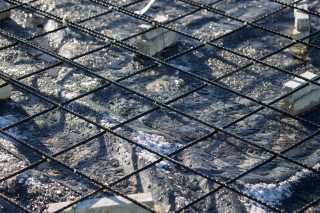
In the meantime Skanska has also been working with HS2’s innovation managers to progress lessons from the trial and use this low-carbon combination of materials in structural reinforced concrete elements beyond roads.

Cementation Skanska, the contractor’s foundations division, has replaced conventional steel and concrete with basalt reinforcement and low carbon concretes, including Cemfree, in creating the new guidewall on the London tunnels section of HS2.
This has come about through a collaboration involving Cementation Skanska with the Skanska Costain Strabag joint venture (SCS JV) – main contractor for the London tunnels section of HS2 – as well as Basalt Technologies, Hanson and guidewall contractor L&A Reinforcements.
Cementation Skanska project director Deon Louw says: “We have a fantastic spirit of collaboration and innovation on the HS2 project, which is really helping to drive industry-wide improvements. This latest trial follows the success of previous innovations on the project, such as zero trim piling.
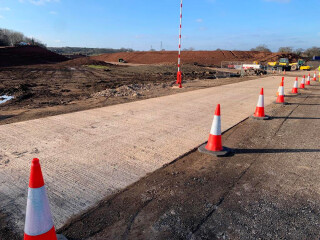
“We’re sharing and applying our learning from different sectors, with this latest use of Basalt technology helped by our work on the M42 J6 highways improvement scheme. We very much hope that this new approach to guidewall construction can be adopted elsewhere in the industry.”
A further benefit is that the guidewall can be broken down safely on site after use and used for the construction of working platforms. This is because the basalt is broken down to a fibre, eliminating the need to separate the concrete crush from steel reinforcement.
SCS JV managing director James Richardson says: “Deploying basalt reinforcement across our project strengthens our ongoing commitment to a cleaner, greener future.”
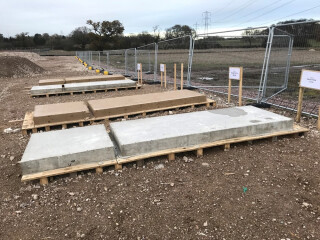
The L&A Reinforcement crew also appreciated it, says director Neil Grace. “The site team preferred working with the material over normal reinforcement due to its weight and ease of use,” he says. “The mesh is supplied to the size required eliminating the need for site cutting. The flexibility of the bars allows them to be placed to a radius without needing them to be pre-bent.”
He concludes: “While the material is marginally more expensive than its steel reinforcement equivalent, due to its design strength smaller diameter bars can be used than if using steel reinforcement – reducing the cost. So it is pretty much cost-neutral. It’s a good product that we would like to see and use more of.”
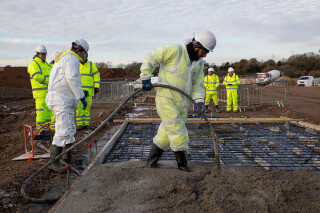
Bright future for basalt fibre
Belgian company Basaltex uses basalt fibres in the manufacture of textiles and construction materials. It says it has achieved “a significant milestone” in developing and testing a new composite material comprising fibres of basalt combined with patented honeycomb technology patented by another Belgian company, EconCore.
The result is a sandwich panel that Basaltex says could be deployed in applications such as cladding panels, partitions, tables and flooring.
EconCore project engineer Jef Delbroek says: “Honeycomb and stone? Some combinations don’t automatically come to mind, but this material solution could enable converters to combine fire safety, light-weighting and sustainability in an elegant way.”
Got a story? Email news@theconstructionindex.co.uk

